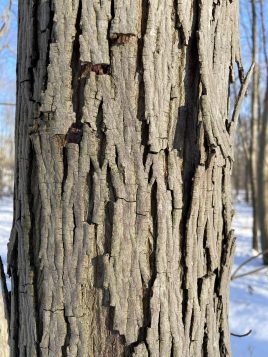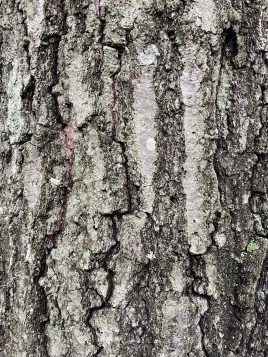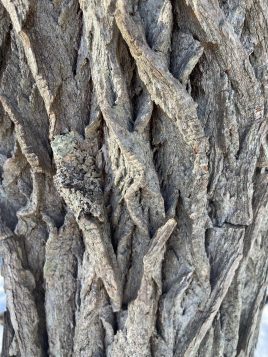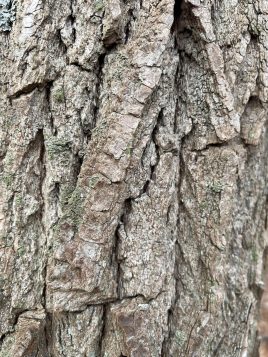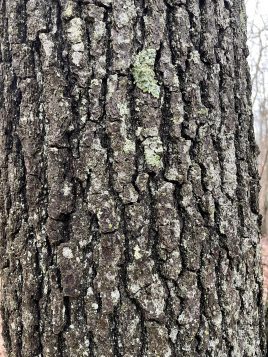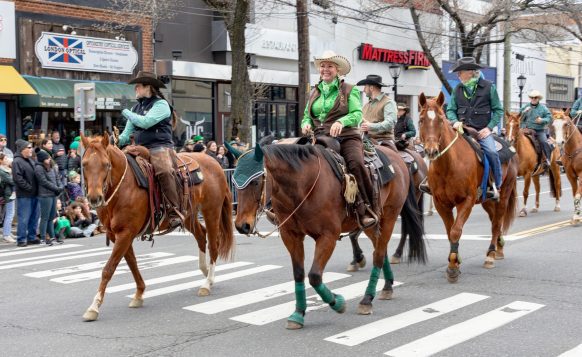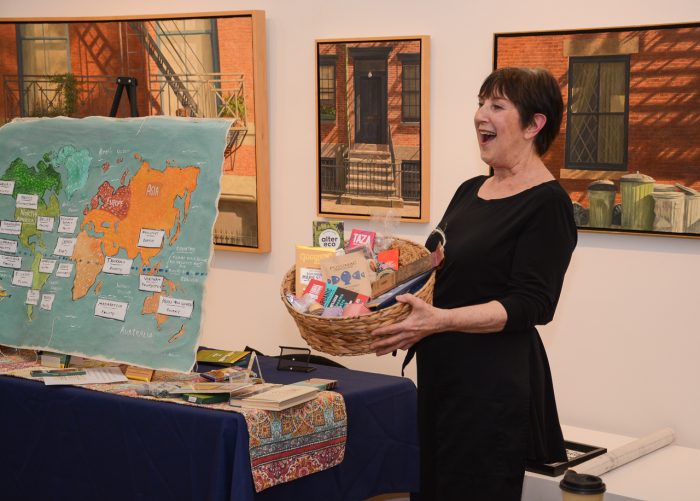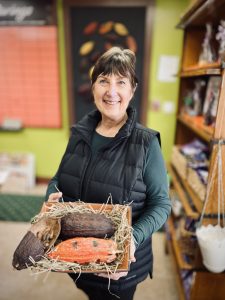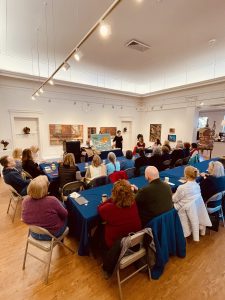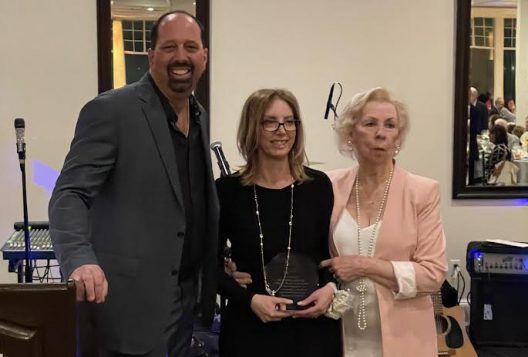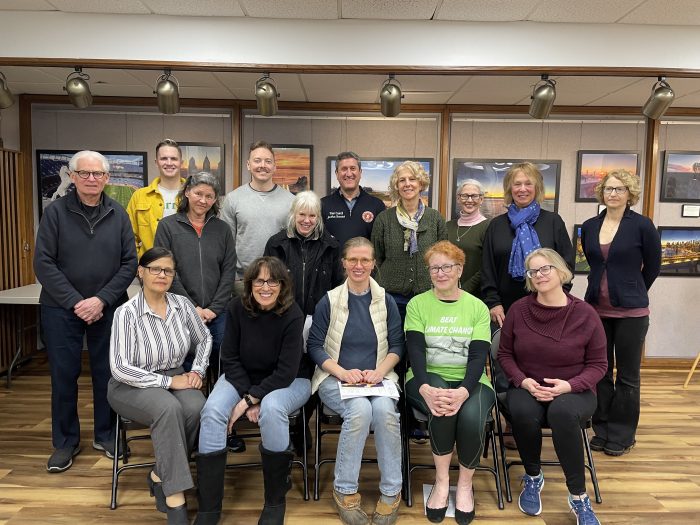By John L. Turner

It’s late morning on a deeply overcast day in early February and a uniform sky of pewter grey threatens rain but, so far, it’s held out. So, wanting to get away from yet another day of news as gloomy as the weather, I decide to do something that always works to pull me out of melancholy — a hike in nature’s realm — knowing that at some point I’ll connect with something seeing or feeling, something that ushers in elation.
Given the season, I won’t gain this expected happiness from seeing colorful things — nature’s color palette this time of year is too subdued, basically a mosaic of brown, black, and grey. Instead, my mind latches on to the concepts of textures and patterns and I’m quickly rewarded by focusing on the skin of trees, many of which possess bark patterns distinctive enough to identify to species. From decades of hiking the Island’s forests they are like familiar friends.
The heavily wooded preserve doesn’t disappoint as I immediately pass several black or sweet birch trees of varying age. Black birch is widespread in the richer soils of Long Island’s north shore. When young, black birch has generally smooth reddish-grey bark with distinctive horizontally parallel rows that are slightly elevated. These rows are known as lenticels and are thought to help the tree “breathe” by allowing gas exchange through the bark. In older specimens the bark becomes more three dimensional with cracks and fissures that look as if a black bear (or mythical dragon) ran its sharp claws down the trunk.
A few of the larger trees are afflicted with the Nectria fungus, or black birch canker, a disfiguring condition that can damage the tree and kill it in severe cases. When growing on the main trunk and larger branches it can cause hollows — while hiking the Tiffany Creek Preserve in northern Nassau County several decades ago, I spied a screech owl sitting in just such a canker-created hollow. The tree’s loss was the bird’s gain.
Another well-known aspect of black birch is that it was once a critical source for a tasty flavoring — oil of wintergreen. Indigenous people used the oil to treat muscle aches and to “purge the body,” while its oil was used in a wider variety of foods and medicines. If you come across a black birch and break off a twig and begin to chew on it, you’ll immediately taste the refreshing flavor of wintergreen.
Moving further along the trail I pass by four of the ten or so oak species native to Long Island — white, black, scarlet, and red oaks. White oak, as its name suggests, has pleasant light-colored bark consisting of thin vertical plates. As the tree ages the bark gets a bit thicker (true for almost all trees) and more “sloughier” with the top and bottom of the bark plates curling a bit.
The other three are a tougher group to identify to species absent their leaves, especially distinguishing the bark of black oak from scarlet oak. Red oak can be distinguished from the other two by its longitudinal “ridges and valleys”; as one botanist has insightfully noted, the surface of red oak bark is reminiscent of what a ski course looks like from the air, the valleys serving as the ski courses while the ridges are the forests left intact in between.
Continuing the amble, I come to another medium sized tree standing alone although surrounded by oaks a little distance removed. I can tell from its somewhat smooth and attractive light grey bark with shallow fissures that I’ve not come across another oak but rather a pignut hickory, one of several hickories found on Long Island. The ridges diverge and blend in a random way creating an intriguing pattern that is fun to look at. This is the group of trees of barbeque fame, their wood imparting a distinctive smokiness to backyard barbeque fare.
While I don’t see any on my walk through this Setauket forest, a cousin to the pignut hickory has among the most distinctive bark of any you’ll see on Long Island — that of the shagbark hickory. If you see the tree you’ll immediately know why it got its name with large patches of shaggy bark curling away from the trunk. It is uncommon on Long Island. A more common hickory which I didn’t see on the hike is mockernut hickory, so named because the very small nut “mocks” the person making the effort to harvest it.
A bit further on and from some light tan leaves fluttering lightly in the understory I knew I had yet another tree species — an American Beech. The bark of beech is light grey and is smooth, making it often an unfortunate target of etched initialed inscriptions. It’s hard to look at the bark and trunk of a large beech and not think of an elephant leg, especially if the wood beneath the bark has a little wrinkle as it often does. The elephant leg analogy is even stronger at the base where the roots flare, looking like elephant toes. Over the past few years many beech trees have been afflicted with beech leaf disease which can be fatal; fortunately this tree shows no signs of the affliction.
One of the main purposes of bark is, of course, to protect the living tissues just underneath from pathogens such as numerous fungal species. But it can also help to protect it from another force — wildfire. And nowhere can you see a better example of this than the bark of pitch pine, the dominant pine of the Long Island Pine Barrens. Pitch pine has very thick bark which provides an insulating layer to protect the living cambium tissue.
Near the end of the loop walk I hit a bunch of medium sized trees of another oak species — chestnut oak, including one multi-trunked specimen sending five, foot-thick trunks skyward. It’s the largest tree in the preserve. Chestnut oak, common in rocky soils found on the Ronkonkoma Moraine, gets its name from the similarity of the leaves to those of the American chestnut, except in the oak the marginal lobes are rounded rather than having little bristles. Its bark is dark grey and deeply furrowed.
At the end of this grouping is another smaller chestnut oak, or so I thought at first. Deeply furrowed bark with inch high ridges, it looks like chestnut oak but I realize the identification is wrong when I look up into the finer branches in the canopy and notice a few of them have smooth green bark (yet another function of bark is, in some trees, to photosynthesize). Suddenly it dawns on me I’m not looking at an oak but rather a mature Sassafras tree, a common species throughout Long Island. I realized I had been barking up the wrong tree …
A resident of Setauket, author John L. Turner is conservation chair of the Four Harbors Audubon Society, author of “Exploring the Other Island: A Seasonal Nature Guide to Long Island” and president of Alula Birding & Natural History Tours.

